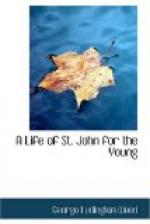[Illustration: BETHANY Old Engraving Page 120]
As he opens the door we see a family of wealth, refinement, hospitality and affection. Its members are of kindred spirit with him: and so would be attracted to him, and he to them. But there was a special bond of union. “Now Jesus loved Martha and her sister and Lazarus.” Such is the tender passing remark of John who elsewhere calls himself “the disciple whom Jesus loved.” These four form a group of special objects of Christ’s affection. They ardently loved Him. We may suppose that John’s relation to the family of Bethany was closer than that of any other disciple. This fitted him to make us familiar with their characters, and many incidents of their home.
John was with Jesus in Bethany in Peraea, when there came the sad, brief, confiding message from Mary and Martha, “Lord, behold, he whom Thou lovest is sick.” Doubtless it touched the heart of the apostle as well as that of his Master, whose response he records: “This sickness is not unto death, but for the glory of God, that the Son of God may be glorified thereby.” We are reminded of John’s own words concerning the change of water into wine: “This beginning of miracles did Jesus in Cana of Galilee, and manifested forth His glory.”
Jesus’ plan for Lazarus included a delay of two days in Bethany of Peraea. Meanwhile His heart went out toward Bethany in Judaea. So did John’s. But, though Jesus tarried, it can be said, as on another occasion, “He Himself knew what He would do.” While John was wondering, waiting and watching, perhaps he remembered how the nobleman’s son was healed in Capernaum when Jesus was in Cana, and thought it possible that the messenger would be told to say to the sisters, “Thy brother liveth.”
When at last Jesus proposed to His disciples that they all go to Judaea, John’s love may have contended for a moment with fear, as they protested, because of danger from His enemies: but it was for a moment only. When Jesus said, “Let us go unto him,” we almost wonder that it was not John the loving, nor Peter the bold, but Thomas the sometimes unready, that said concerning Jesus, “Let us also go that we may die with Him.” But we imagine that John was the readiest to go, and kept the closest to his Master in the pathway to Bethany in Judaea.




